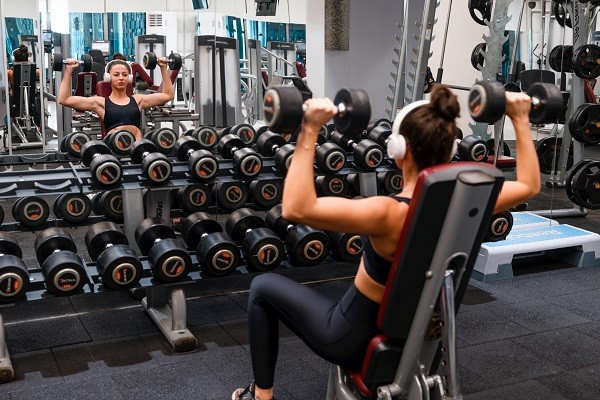While strength training is fantastic for muscle growth, bone health, metabolism and mental wellbeing, a common complaint among lifters is shoulder pain. Let’s break down what’s happening, why it occurs and how you can recover safely and keep training.
Understanding the Shoulder: A Delicate Balance
Before diagnosing pain, it helps to know how the shoulder is built and how it works. The shoulder complex includes the humerus (upper arm bone), scapula (shoulder blade), and clavicle (collarbone). But it’s not just one joint – the shoulder comprises four key articulations:
- Glenohumeral joint (ball-and-socket between humerus and scapula).
- Acromioclavicular joint (between acromion of scapula and clavicle).
- Sternoclavicular joint (between sternum and clavicle).
- Scapulothoracic “joint” (the gliding of scapula over chest wall).
The humeral head sits in the glenoid fossa (part of the scapula), which is relatively flat. This design allows for an extraordinary range of motion, but inherently offers less inherent stability. That’s where surrounding soft tissues – ligaments, the joint capsule, synovial membranes, bursae (fluid sacs), and muscles – play a critical role in stabilising and guiding motion.
Among these muscular supports, the rotator cuff group is especially important, as it gives dynamic stability while the joint moves. The bursae reduce friction between moving parts. The synergy of all these structures allows you to lift, push, pull, and rotate, but if any part is weak, inflamed or compromised, pain can follow.
Why Shoulders Hurt During Weightlifting
Weight training exerts stress on muscles, tendons, ligaments and joints. When loads are too heavy, technique is flawed, or recovery is neglected, the risk of injury increases. Here are common pitfalls:
- Technique breakdown: Poor form causes compensations and overload in unintended structures.
- Lifting too heavy: Pushing beyond your structural readiness can cause acute damage.
- Overtraining / insufficient rest: Muscles, tendons, and joints need time to recover between sessions.
Because many shoulder injuries present with overlapping symptoms, self-diagnosis is tricky so always consult a health professional if pain persists. The expert physios at Melbourne Sports Physiotherapy are trained and experienced in shoulder pain, able to provide a tailored approach for your injury.
Common Shoulder Injuries & Conditions
1. Rotator Cuff Tears
A tear in one or more rotator cuff tendon(s), either partial or full thickness. This may happen acutely such as lifting something too heavy, or over time via repetitive stress.
Symptoms: Pain at rest or at night, discomfort during movement, weakness, stiffness.
2. Rotator Cuff Tendinopathy
This is degeneration and inflammation of a rotator cuff tendon, usually from overuse.
Symptoms: Pain on the outside of the upper arm, pain when lifting overhead or outward, gradual weakness, sometimes swelling.
3. Subacromial (Shoulder) Impingement
One of the more common issues when lifting weights. This occurs when structures (tendons, bursa) get pinched in the subacromial space (just below the acromion).
Symptoms: Pain in the shoulder, pain on overhead movement or behind the back, discomfort lying on that side, weakness.
4. Biceps Tendonitis
Inflammation of the tendon of the biceps muscle often results from repetitive lifting or overuse.
Symptoms: Local pain and tenderness, possible swelling, weakness.
5. Subacromial Bursitis
Here, one of the bursa sacs becomes irritated or inflamed, often from repeated friction or overload.
Symptoms: Persistent shoulder pain, stiffness, signs of inflammation.
6. SLAP Lesion (Superior Labrum Anterior to Posterior Tear)
This involves a tear in the glenoid labrum (the cartilage rim of the socket). In weightlifters, lifting heavy often exacerbates this.
Symptoms: Clicking or popping, pain with overhead movements, difficulty internal rotating or pressing across the body, weakness.
What You Can Do: Recovering & Preventing Shoulder Pain with Physio
Because many of these conditions share similar symptoms, it’s difficult to pinpoint the exact cause without proper assessment, which makes seeing a physiotherapist valuable. A trained practitioner uses special tests and manual techniques to distinguish between them.
To help your shoulder recover and hopefully never let you down in the gym again:
Reduce load or take a break.
Resting or lowering your intensity gives inflamed tissues a chance to heal.
Guided rehabilitation.
Under professional supervision, your rehab may include:
- Mobility / range-of-motion exercises to maintain or restore healthy joint motion.
- Strengthening of rotator cuff, scapular stabilisers and surrounding musculature.
- Joint mobilisations – manual techniques to reduce stiffness or restore proper joint mechanics.
- Taping or bracing to offload stress while healing.
- Technique analysis and correction – often the root issue is poor movement patterns.
- A tailored home-exercise program aligned with your goals, schedule and injury status.
If your pain continues or worsens, further diagnostic imaging such as an ultrasound or MRI may be needed, and possibly more advanced medical interventions.
Shoulder pain while lifting doesn’t always stem from one obvious cause. Because the shoulder is a complex and delicate structure, injury often arises from a combination of strain, weakness, poor technique or overuse. Identifying the issue early, reducing stress on the joint, and employing a guided rehab strategy significantly improves outcomes.
If you’re experiencing persistent shoulder pain when lifting, book an assessment with a physiotherapist who specialises in shoulder and sports injuries at Melbourne Sports Physiotherapy. With the right diagnosis and recovery plan, many people return to pain-free lifting, often stronger and smarter than before. Call to speak to the team or book an appointment online.

